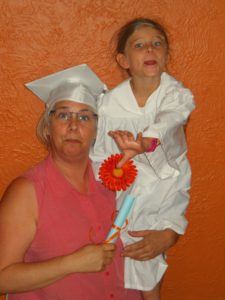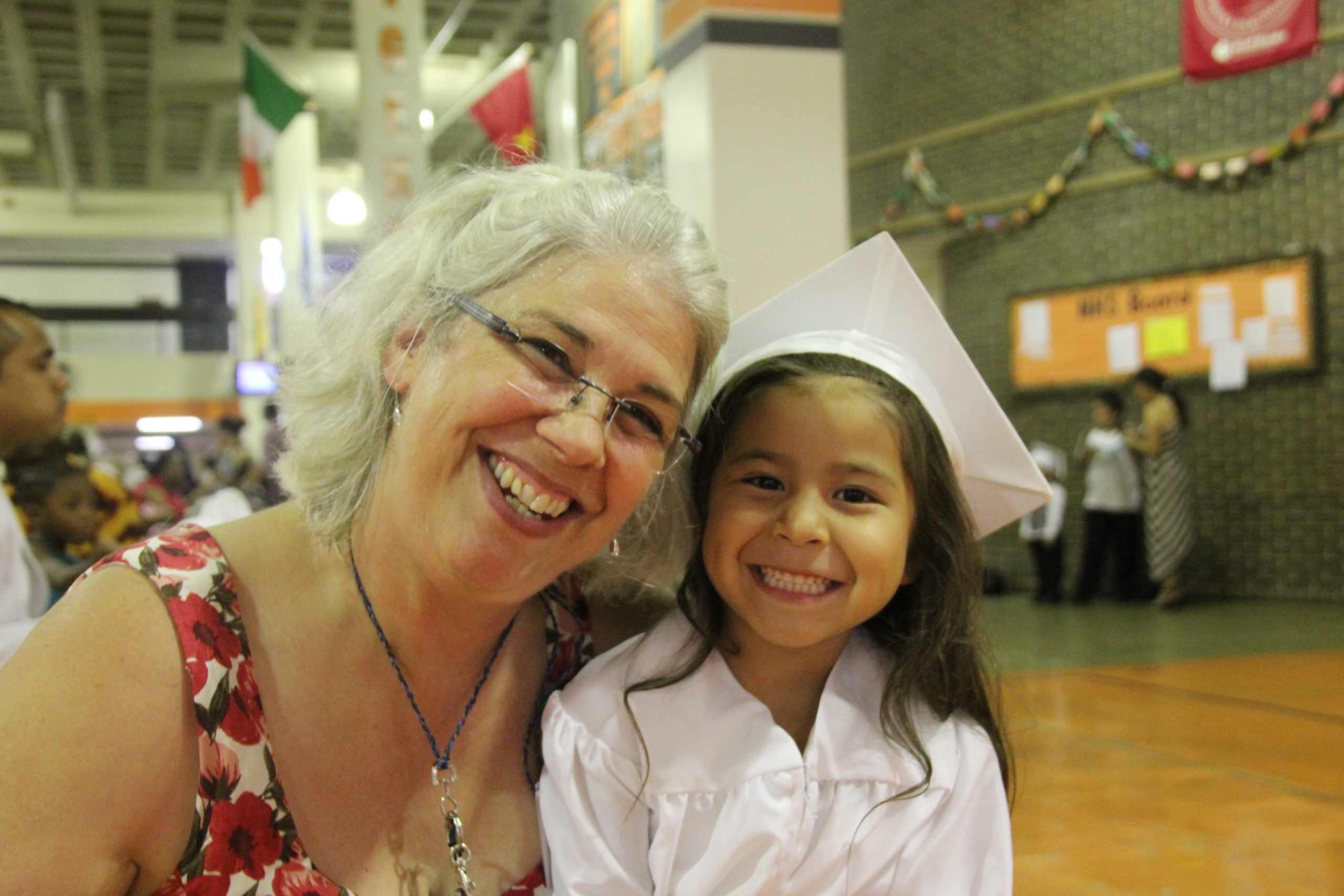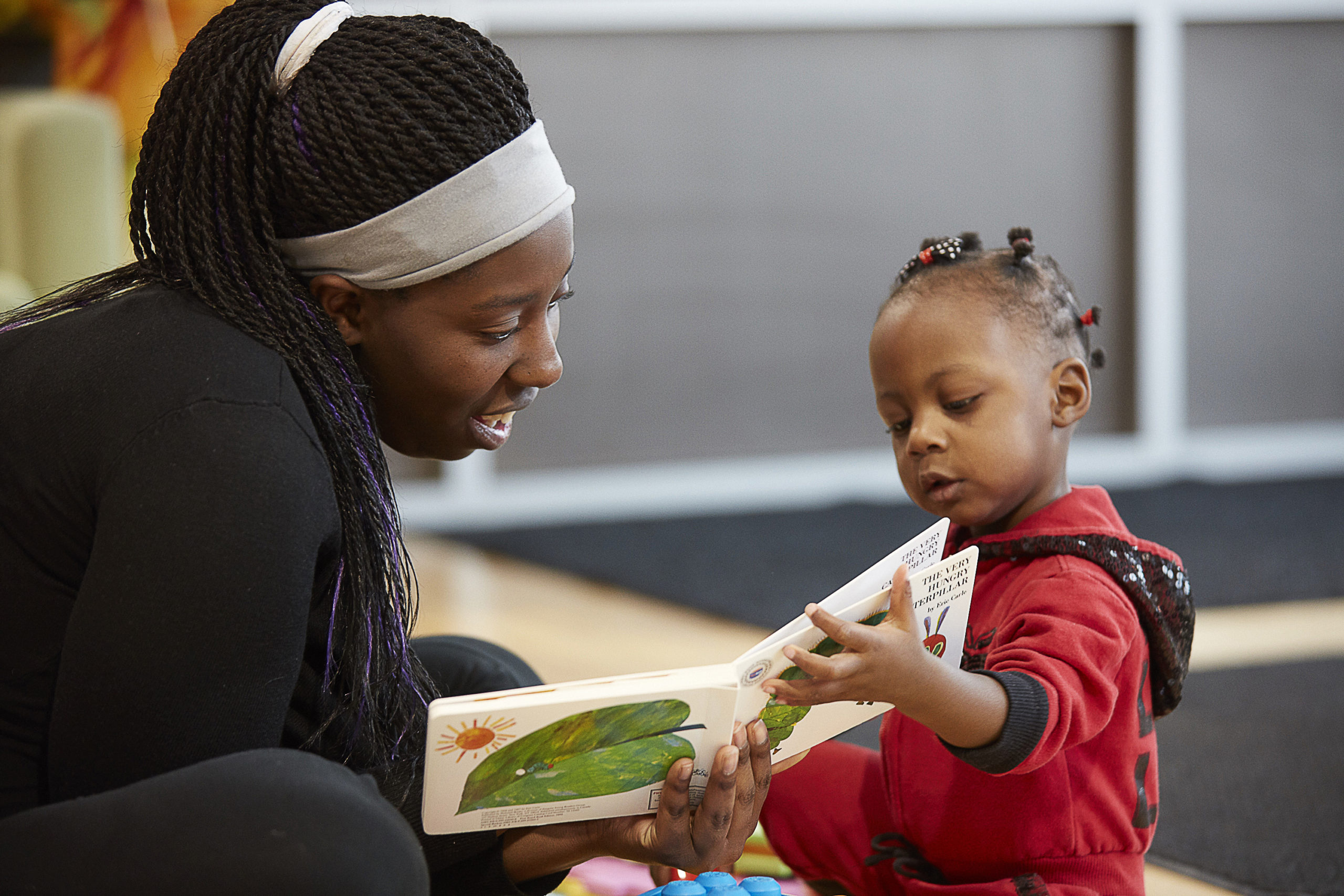Last fall, Waabomiimii began attending Way to Grow Preschool P.A.L.S. after her mom met Miriam, one of our Family Educators, at a recruitment event. At four years old, Waabomiimii did not know her ABCs or how to count, but over the last year she has grown tremendously. Making leaps and bounds, Waabomiimii now knows all letter sounds, is counting up to 20, and has passed the nationally recognized IGDI early literacy assessments indicating that she is ready for kindergarten!
Itzel, Waabomiimii’s mom, is very happy with Waabomiimii’s progress and has enjoyed watching her daughter grow. “In just one year,” Itzel tells us, “Waabomiimii has learned the alphabet, how to write numbers, and count. She has learned rhyming words and is now learning how to read!”
Combined with our preschool parent-child classes and home visiting program, Itzel’s engagement has been instrumental in Waabomiimii’s success. “Mom always works very hard between home visits,” Miriam says. “She has done a great job with Waabomiimii over the past year on everything from counting and reading, to following through on rules. When she gets home from work, she now sets aside time each night to practice learning with Waabomiimii.”
During home visits, Miriam continues to work with Waabomiimii and Itzel on reading. “Waabomiimii is working on continuing to build her sight-word recognition – a critical first-step in early literacy,” Miriam says. “When I visit, we do a lot of shared reading, a technique we commonly use in our curriculum.” Shared reading, a strategy where students and adults read aloud together, provides guidance and support to the child as they learn new words. “I usually start by reading a sentence, then engage mom by having her read next. Mom then reads while pausing on the sight-words Waabomiimii knows to allow her to read the sight-words aloud,” Miriam describes. “Now they like it so much that mom is reading with Waabomiimii 10-20 minutes each day! They also visit the library regularly so they can continue to enjoy new books together.”
This month, Waabomiimii walked across the stage at the Way to Grow Early Learner Graduation and in a few short weeks, she will begin her next journey as she starts kindergarten. Thanks to mom’s hard work, and the help of Miriam and the Way to Grow preschool teachers, we are happy to report she is ready to succeed!
I worked for several years as a Special Education Educator’s Assistant before returning to earn a Master’s Degree in Early Childhood Special Education. After one year at a local school, I quickly realized the classroom was not the place for me. I didn’t feel like I could be as effective as I wanted to be without being able to reach families at home.
Today, I bring that perspective with me to the families I serve. I remember what it was like to be a teacher. I also remember the assumptions that came with it. There are many wonderful teachers, but I also think it is human nature for people to assume and to blame rather than to turn that lens on themselves. Teachers are no exception to that and often times, it’s the parents that fall victim to the blame. Meanwhile, parents are also at times relying too heavily on the school.
Way to Grow works to bridge that gap between home and the school. In the home, I start by first and foremost affirming the parent. I do not come in with all the tasks they need to complete and hoops they need to jump through for them to be the type of parent I want them to be. Yes, I set goals for each of my families, but I also encourage them to be open with me about the obstacles they see that could potentially prevent them reaching those goals.
Then we make a plan.
When it comes to getting parents more involved in the school, it helps to remind them that there isn’t a big wall between home and school, and to tell them that teachers actually want you to cross into their classrooms. You’d be surprised how many parents think, “I’m at home. The teacher is at school. I don’t want to interfere with what the teacher does.” A lot of what I do after breaking down that barrier is then encouraging them to be the best advocate for their kids that they can be, even if walking into that classroom means they are reliving the shame of perhaps not graduating high school or revisiting all of their own unmet expectations.
The second part of what Way to Grow does is help the parents realize their own role in supporting their child’s education. Children do not just go to school to learn – they learn from you every day. A large part of what I do is to help open, and sometimes facilitate, communication between the parent and the school. Sometimes parents may not feel open enough to share with the teacher they may be homeless or they may not think the school needs to know their car was broken into. That’s where I am able to pick up the phone or send an email to let the teacher know what is going on. So often, there is so much more than meets the eye. To be in the home and to have this line of communication (through the release of information) is very effective. It’s huge to be the eyes and ears for the teacher where the teacher can’t go. Once communication has been established and teachers see that parents are there for their child, things go much better.
 Collette is celebrating her 5th year as a Family Educator with Way to Grow. She is currently serving 30 families that collectively include over 100 parents and children! Through her time and work with us, we know she has touched the lives of many more. Thank you, Collette for all you do to give our kids a brighter future.
Collette is celebrating her 5th year as a Family Educator with Way to Grow. She is currently serving 30 families that collectively include over 100 parents and children! Through her time and work with us, we know she has touched the lives of many more. Thank you, Collette for all you do to give our kids a brighter future.
Throughout the year, Way to Grow hosts Family Game Nights as part of our Great by Eight program. On average, over 30 families attend and each family receives a game to take home. These events have become a favorite for Way to Grow families. We feature a different game each time and wanted to share a few educational games we have found to be kid tested, and educator approved!
- Brain Quest
Brain Quest is the perfect bring-along game for those trips out of town. Play it in the car, or make a night of it by hosting your own trivia night. Skill areas: Critical thinking, information recall, and listening - Farkle
Farkle is a fun game of strategy and luck! Take a risk and keep rolling to build your score, or play it safe so you don’t lose your points. Skill areas: Math and critical thinking - Memory
This classic game is easy to play with children of nearly any age. Print your own like this fun shape version, or create your own using paper and markers. Try using letters of the alphabet, numbers, colors, shapes, or pictures tailored to what your child is learning. Skill areas: Critical thinking, information recall, and topic you choose! - Pictionary
Pictionary is an easy game to play with no supplies (other than a pen and paper) required! Draw the first thing that comes to mind or create your own word bank for children to draw from. Then, set the clock! Skill areas: Fine motor skills, creative thinking, and vocabulary - Puzzles
Puzzles have many benefits to early childhood development. They promote not only cognitive skill development, but social-emotional skills such as concentration and patience as well. Skill areas: Fine motor skills, memory, critical thinking and problem-solving - Qwirkle
Qwirkle was a huge hit at our most recent Family Game Night. Players take turns adding blocks adjacent to at least one previously played block. The blocks must match either the color or shape of the previous block. Skill areas: Color and shape recognition, pattern building - Spot it!
Spot it! is played with 31 cards that are each decorated with colorful images. The images may vary in size and position, but there is always one, and only one, match between any two cards. The aim of the games is always the same: be the first to spot it. Each game includes variations for all skill levels. Spot it! Jr. is for ages 4-7, though we think this game is just as fun for adults, too! Skill areas: Vocabulary building, cognitive processing speed, visual perception, and motor skills - Story Cubes
This compact, pocket-sized game packs a lot of fun! Practice your creative storytelling skills together, or alone. Story Cubes come in many themes from prehistorical times to enchanted fairy tales. For older children, practice writing out the stories to increase the target skill areas. Skill areas: Creative thinking and storytelling - Uno
Uno has been a family favorite for decades and for good reason. Easy for children to pick up and hard to put down, this game is fun for all ages. Skill areas: Strategic thinking, color and number recognition - Zingo
Another Way to Grow Family Game Night favorite is Zingo. Practice matching images and words to your Zingo card. Fill your card to win! With two levels, this game is perfect for ages 4-8. Skill areas: Vocabulary, matching, and sight word recognition
Way to Grow Preschool teachers compiled this list of preschool reading books essential to any little one’s library. You will recognize many of these preschool reading books as early childhood favorites. Unfortunately, we know many of the children in our program lack access to these books and many like them. We also know that a pathway to success begins by ensuring every young person has access to books from the moment they are born. In response to this need, insurance professionals attending the 2016 SITE conference will be collecting these titles to benefit Way to Grow families. These books will supplement our home visiting curriculum and to help encourage parents to read to their preschoolers daily by fostering an early love for reading.
- Amazing Grace by Mary Hoffman
- Bear Snores On by Karma Wilson
- Brown Bear, Brown Bear, What Do You See by Eric Carle
- Chicka Chicka Boom Boom by Bill Martin Jr.
- Frog and Toad by Arnold Lobel
- Goodnight Moon by Margaret Wise Brown
- Henry and Mudge by Cynthia Rylant
- If You Give a Mouse a Cookie by Laura Joffe Numeroff
- Make Way for Ducklings by Robert McCloskey
- The Lion and the Mouse by Jerry Pinkney
- Swimmy by Leo Lionni
- The Rainbow Fish by Marcus Pfister
- Chrysanthemum by Kevin Henkes
- The Snowy Day by Ezra Jack Keats
- It’s Mine by Leo Lionni
- Leo the Late Bloomer by Robert Kraus
Print this list of preschool reading books!
At its core, early literacy development begins with what children know about reading and writing long before they themselves can read and write. Here are a few tips to help promote early literacy development at home:
1. Enjoy more conversation
Make the most of the time you spend with your child by simply talking and listening to them more. Listen to children’s songs in the car or use this valuable time together to talk about anything from the alphabet to the weather.
2. Avoid baby talk
Stick to more grown up language to build a long lasting foundation for literacy development. Many activities can promote rich language use, such as visiting a museum, zoo or other exhibit. You’ll find yourself using words to describe your surroundings in these settings that you may not often use in routine conversation.
3. Bring back the bedtime story
Researchers estimate that less than half of children under the age of five are read to daily. Reading with your child from birth is one of the best ways to promote early literacy development. Just a few minutes a day makes a big difference, so take a trip to the library and make sure you aren’t forgetting those bedtime stories!
4. Expand on school projects
If you don’t know what your child is working on in school, ask their teacher to share their unit plans. Once you know what your child is learning, build on those lessons at home to help deepen their knowledge and draw more connections to them. Have fun with this! If, for instance, your child is learning the letter “B” this week, take them to the beach (weather permitting), or create a collage using magazine and newspaper clippings of items or activities that start with the letter “B”. If your child is a little older, and perhaps learning about the environment, check out a really cool book about the rainforest, and talk about the differences between that environment and the one in which they live.
5. Encourage them and express pride
Nothing fosters a love for learning faster than the encouragement of a proud parent. Whether your child just learned their ABCs or finished their first chapter book, be sure to tell them what a great job they have done. Recognizing their hard work paying off will set healthy patterns for the future.
Imagine a three-year old girl, born into poverty. Her parents may not have finished high school and statistically, it’s even less likely anyone from her family has ever graduated college. Let’s say she defies the odds and graduates high school on time, but shortly after, she becomes pregnant. She seeks help and finds herself at Way to Grow. As she grows more confident in her ability to create a different path for her child, she decides to go back to school, becoming a first generation college student.
It isn’t easy. She will face many challenges; How can I afford school? Who will care for my child when I’m in class? What about transportation? Where will I find the time to work, study, and raise my child on my own? The unfortunate reality is that a disproportionately low number of first-generation students succeed in college. However, there is a path forward.
Her daughter already has a childhood that looks much different than her own. She will reap the benefits of a childhood where her mother knows the importance of living healthy, reading with her child daily, and advocating for her daughter’s education. Her mother spends time with her to read and uses everyday experiences as an opportunity to teach. Her mother is involved in her school, and this little girl grows up knowing her mom is the number one advocate for her education. The bar has been raised. Education is no longer simply a choice, but an expectation. With this, a second generation is born. She learns to pick up the torch from where her mother left off, and continues to blaze forward on the path of educational attainment towards greater social opportunities – A hope we all share for our children.
Powerful isn’t it? The daughter in this story is more likely as a second generation college student to persist beyond three years of higher education, and that much closer to earning her bachelor’s degree; arguably the most important rung in the educational attainment ladder in terms of upward social mobility. This is why early childhood education and parent engagement matters. This is why Way to Grow matters.
Dr. Mary Dana Hinton, 15th president of the College of Saint Benedict will deliver a keynote address at the Way to Grow Spring Luncheon.
Join Dr. Hinton as she delves deeper into the power of the second generation >>
In 2013, Way to Grow was selected as one of six (SIF) fund recipients in the Twin Cities, which included a $100,000 investment from the Social Innovation Fund to expand our Great by Eight home visiting model. The goal of this project is to determine if the Way to Grow Great by Eight program is a scalable, replicable model for early childhood and parent success.
The initial findings* provided credible evidence that our programming is achieving our stated impact, improving parent engagement, school readiness and academic proficiency among participating students.
Initial Findings SIF Evaluation – Parent Engagement
- Frequency of home visits was a significant positive predictor of higher nurturing, discipline, support of child development and child care scores.
- Frequency of home visits, both early learning and elementary, was a significant predictor of parent-teacher conference attendance.
- Frequency of elementary home visits was a significant predictor of parents attending a school event or volunteering.
Initial Findings SIF Evaluation – Academics
- Home visits the summer before kindergarten were a significant positive predictor of higher Individual Growth and Development Indicators (IGDI); when frequency of home visits increase, indicator scores increase.
- Program participation duration is significantly associated with higher DIBELS scores.
- Non English speaking children scored significantly higher on DIBELs compared to children with English as home language.
- Highest gains were seen in mathematics (16.37 points) based on MAP scores, fall to spring.
- The second highest gain was seen in informational text (reading) based on MAP scores.
- The third highest gain was seen in the vocabulary scale based on MAP scores.
*Way to Grow received its initial evaluation findings in 2015, completed by the University of Minnesota’s Center for Applied Research and Educational Improvement through the guidance of the Corporation for National and Community Service, made possible through a grant from the Greater Twin Cities United Way in partnership with Generation Next and the STRIVE Network.
 Great by Eight is supported by subgrant from the Social Innovation Fund (SIF), a program of the Corporation for National and Community Service. The Social Innovation Fund combines public and private resources to grow the impact of innovative, community-based solutions that have compelling evidence of improving the lives of people in low-income communities throughout the United States.
Great by Eight is supported by subgrant from the Social Innovation Fund (SIF), a program of the Corporation for National and Community Service. The Social Innovation Fund combines public and private resources to grow the impact of innovative, community-based solutions that have compelling evidence of improving the lives of people in low-income communities throughout the United States.
 Mark your calendars! Dr. Mary Dana Hinton, 15th president of the College of Saint Benedict will deliver a keynote address at the Way to Grow Spring Luncheon. In a time of challenges, her one hope is to improve access to education – starting early, providing families with holistic support with access to intentional programs as a way to ensure success. We are excited to hear Dr. Hinton share her personal experiences and passion for helping families achieve success from prenatal through college.
Mark your calendars! Dr. Mary Dana Hinton, 15th president of the College of Saint Benedict will deliver a keynote address at the Way to Grow Spring Luncheon. In a time of challenges, her one hope is to improve access to education – starting early, providing families with holistic support with access to intentional programs as a way to ensure success. We are excited to hear Dr. Hinton share her personal experiences and passion for helping families achieve success from prenatal through college.
Dr. Hinton earned a Ph.D. in religion and religious education with high honors from Fordham University, a Master of Arts degree in clinical child psychology from the University of Kansas, Lawrence and a Bachelor of Arts degree in psychology from Williams College. She has extensive administrative experience in Catholic higher education, national experience with non-profit K-12 education management and school development, and a philanthropic background in the corporate sector. Dr. Hinton’s scholarship focuses on African American religious history, religious education, and leadership, strategic planning, assessment, and diversity in the academy. She is the author of “The Commercial Church: Black Churches and the New Religious Marketplace in America.”
Dr. Hinton is a member of the Minnesota Private College Council Board of Presidents, the Greater St. Cloud Development Corporation Board of Directors, the International Women’s Forum of Minnesota, and the Bonner Foundation Presidents’ Advisory Council. Since 2012, she has taught in the University of Pennsylvania Graduate School of Education doctoral program in higher education management.
Event details:
Way to Grow Spring Luncheon
at the Walker Art Center
Thursday, April 28, 2016
11:45-1:00 pm
This is a free event, however space is limited.
Save your seat today at waytogrow.org/events
With the primary election in full swing, we’ve heard a lot of talk from the candidates on other pressing issues, but what are their views on education? No matter who you support, or which party you belong to, education affects the prosperity of us all as individuals, as communities, and as a nation.
Here’s where the candidates stand (in five bullet points):
Hillary Clinton
• In favor of universal pre-k
• Believes in established right to education from preschool through college
• Supports scholarships for teachers who go to urban schools in effort to get more teachers into hard-to-serve areas
• Opposes Common Core
• View on vouchers: Against
Ted Cruz
• Supports cutting government spending on education/abolishing the U.S. Department of Education
• Believes school choice is “the civil rights issue of the 21st century. Every child deserves a fair chance at a quality education.”
• Advocates the right to education via public, private, charter, or home school
• Opposes Common Core
• View on vouchers: Supports
Martin O’Malley
• In favor of universal pre-k
• Supports focus on the early years and expanding pre-k as well as after-school programs
• Believes under-performing public schools need more resources
• Opposes Common Core
• View on vouchers: Against
Marco Rubio
• Expressed support for early learning programs while arguing they’d be better run by states, but hasn’t yet taken or supported any concrete policy action
• Promote voluntary pre-k scholarships and scholarships to low-income families and students in chronically failing schools
• Supports school choice
• Would like to create a national online learning program
• Opposes Common Core
Bernie Sanders
• Supports quality, affordable education, from child care to higher education
• Advocates for reducing class size to 18 children in grades 1-3
• Proposes $25 billion to renovate and repair elementary schools
• Opposes Common Core
• View on vouchers: Against
Donald Trump
• Supports cutting the Department of Education down in size and spending to localize education, but hasn’t indicated yet in what ways or how much
• Believes school choice will improve public schools
• Would like to “bring on the competition and tear down the union walls”
• Opposes Common Core
• View on vouchers: Supports




